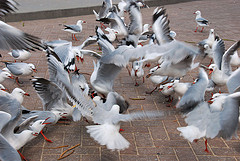The Carefully Curated Unconference
Alexandra Carmichael
November 9, 2011
Quantified Selfers really love to gather face to face, sharing stories and experiments and tips. I’ve even had the humbling experience of people telling me that coming to a QS event changed their life.
So how do we put together our events, to encourage this deep, collaborative learning? With our first European QS conference coming up 2 weeks from now in Amsterdam, now seems like a good time to reflect on our process.
What we create is a carefully controlled balance between order (top-down, lecture-only conferences) and chaos (bottom-up, created-on-the-fly unconferences). You could call this hybrid model “the carefully curated unconference.”
Here’s what we do:
1. Find a flexible space. We mix up plenary sessions in big rooms with breakouts in small rooms, with very generous breaks for people to talk to each other. It’s great to have quieter spaces for people to hang out as well as open central areas. Here’s a sample schedule to see how it flows.
2. Invite all attendees to speak. Rather than seeking out “big name” keynoters to draw people to the conference, we recognize that every person coming has an interesting story to tell. So we invite people, when they register, to share a link to a Twitter page or personal web site. We click on every one of these links, trying to figure out who is coming and what they care about. Then we write to every person, asking if they would like to present a short talk or lead a breakout discussion. We get involved in countless email threads. It is a ton of work, and also very inspiring and fun.
We typically find that one quarter of attendees want to be speakers. At our last conference in Mountain View, this meant a rich and diverse program of 100 speakers.
3. Create a thoughtful order. Because speakers come in right up until a few days before the conference, we like to wait until fairly close to the event to announce the program. We spend a lot of time thinking carefully about whether we have all the important topics covered, who would make inspiring plenary speakers, and how to cluster talks and breakouts in thought-provoking ways. The speaker lineup for Amsterdam just went live yesterday!
4. Keep the price affordable. As a social enterprise, we’re not trying to make huge profits from our events. We do need to cover our costs, but we also give out a lot of scholarships to PhD students or people in financial need. This is made possible in part by sponsorships from generous people at Autodesk, Basis, Bodymedia, Creative Commons, Fluxtream, Fujitsu, Gain Fitness, Genomera, HealthTap, Humana, Intel, Kaiser Permanente, Limeade, MedHelp, Microsoft, Mohr Davidow, Philips, Quantter, Scanadu, WellnessFX, and Zeo. Thank you so much.
5. Focus on the in-person experience. We don’t generally put a lot of effort into videotaping every session, or livestreaming the event, or documenting every talk in writing. To really experience a QS event you have to be there in person. At the beginning of the conference, we set the tone – this is a weekend for collaboration and learning, you are free to spontaneously start new sessions as ideas pop up, everyone here is an expert, it’s more important to dive deeply into conversation with a newfound connection than to attend every session. Bring your full attention to where you are, and tweet later.
6. Recognize the volunteers who make it happen! I want to publicly call out thanks (in alphabetical order) to Bo Adler, Jelle Akkerman, John Amschler, Martijn Aslander, Alex Bangs, Robin Barooah, Farid Behnia, Matthew Bright, James Burke, Sara Cambridge, Matthew Cornell, Steven Dean, Maarten den Braber, Eri Gentry, Denis Harscoat, Karen Herzog, Chia Hwu, Scott Jackisch, Rajiv Mehta, Michael Nagle, Joost Plattel, Kees Plattel, Ernesto Ramirez, Richard Sachs, Matthew Trentacoste, and Yuri van Geest, for all their dedicated help in making our events amazing. Also, thanks to all the people who step up to help in the moment. We couldn’t do it without all of you.
7. Recover, learn, repeat. After each conference comes a period of reflection, self-care, and rest. We look at what went smoothly, what didn’t, and what attendees suggested to improve for next time. Before long, we’re planning the next inspiring event. So much fun!
We hope to see you and hear your self-tracking story at an upcoming event!
(Thanks to Chewy Chua for the great photos.)




